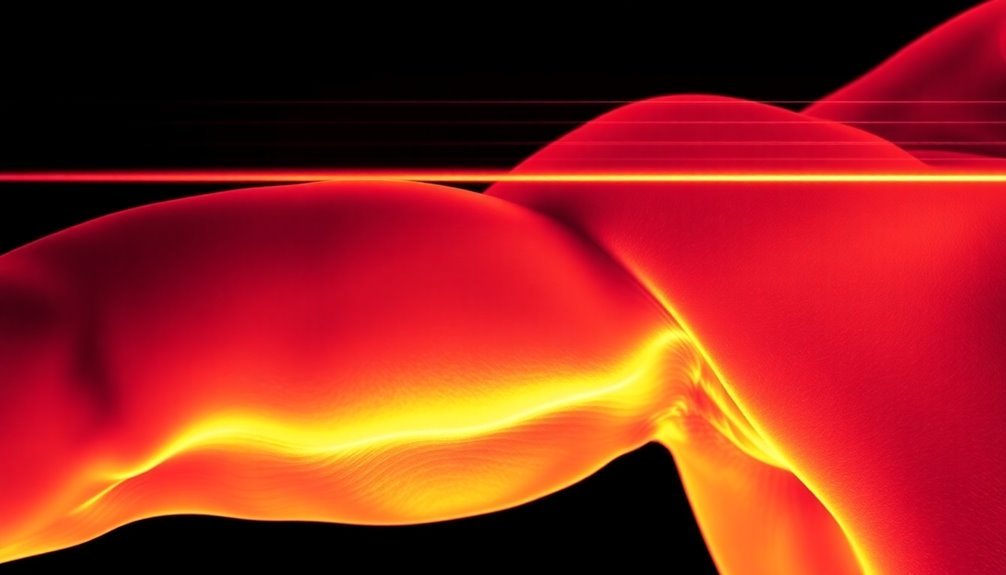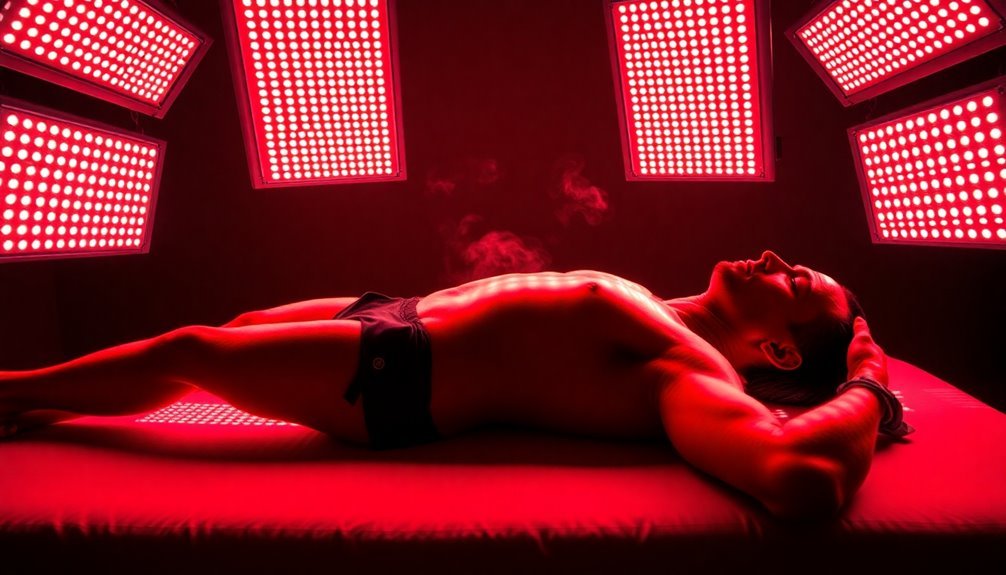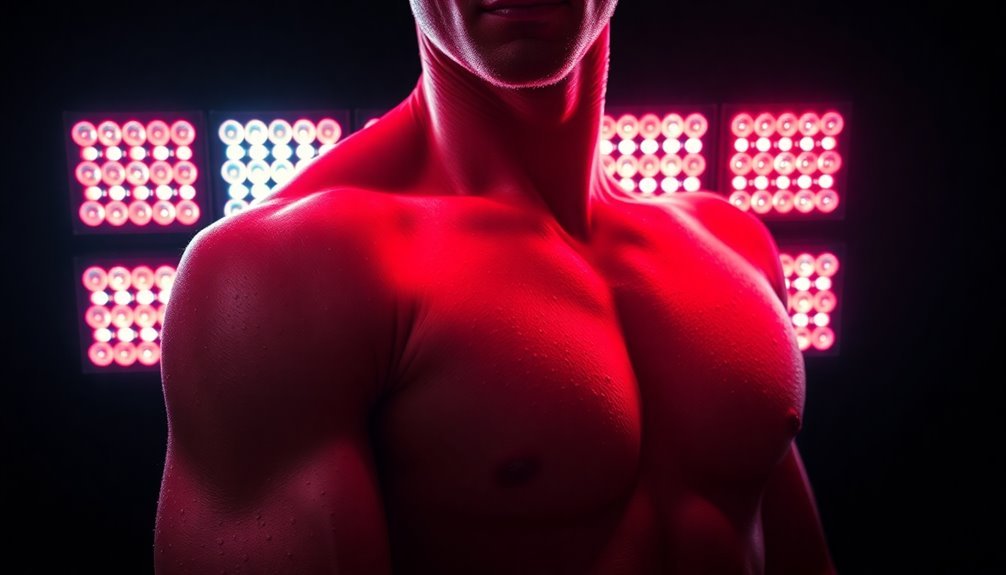Three scientifically proven wavelengths can supercharge your muscle recovery: red light (630-700nm), near-infrared (700-900nm), and combined protocols using both ranges. Red light triggers enhanced ATP production and cellular repair, while near-infrared penetrates deeper into tissues for improved circulation and reduced inflammation. When you combine these wavelengths, especially in the 640/875/905nm or 660/850nm ranges, you'll experience faster healing, reduced muscle fatigue, and better overall performance. For ideal results, apply these therapies for 10-20 minutes per muscle group, 3-4 times weekly. Understanding the specific benefits of each wavelength will help you maximize your recovery potential.
Near-Infrared Range 700-1200nm

Three key characteristics make near-infrared light (700-1200nm) particularly effective for muscle recovery.
First, it penetrates deeper into your tissues than red light, especially in the 700-900nm range.
Second, it's absorbed by cytochrome c oxidase in your mitochondria, enhancing ATP production vital for muscle repair. The absorption process triggers photobiomodulation effects in cells.
Third, it reduces inflammation while improving cellular communication for better muscle coordination.
You'll experience multiple benefits when using near-infrared light therapy correctly.
It accelerates healing through enhanced cell regeneration, reduces delayed onset muscle soreness (DOMS), and improves blood circulation to remove metabolic waste.
Additionally, it can help normalize your thyroid hormone levels, which directly impacts energy production.
To maximize these benefits, you'll want to follow specific guidelines.
Use the therapy for 10-20 minutes per muscle group, keeping the device 6-12 inches from your skin.
You can apply it both pre-workout to boost performance and post-workout to speed recovery.
For ideal results, maintain a frequency of 3-4 sessions weekly, though daily sessions are acceptable during intensive recovery periods.
When selecting a device, verify it offers adjustable intensity within the effective 700-1200nm range.
Red Light 630-700nm
Several compelling features make red light therapy in the 630-700nm range a powerful tool for muscle recovery. When this specific wavelength penetrates your muscle tissue, it triggers photobiomodulation, enhancing your body's ATP production and cellular function. You'll find this particularly beneficial as it directly supports your muscle repair process and reduces inflammation. Studies have shown that red light therapy is especially effective for treating delayed onset muscle soreness.
You can maximize the benefits by applying red light therapy 3-6 hours before your workout, though it's also effective post-exercise. The recommended dosage of up to 60 Joules helps optimize your recovery potential, and you'll get similar results whether you're using LED devices or lasers. When you combine red light with near-infrared wavelengths, you may experience even better outcomes.
Clinical evidence strongly supports these benefits. You'll typically notice reduced muscle soreness, improved range of motion, and enhanced overall muscle performance.
The therapy works by stimulating your mitochondria through cytochrome c oxidase absorption, leading to increased cellular energy and better intercellular communication.
What's particularly reassuring is that studies haven't reported any significant side effects, making it a safe addition to your recovery routine.
Combined Wavelength Recovery Protocol

In light of recent research, combining multiple wavelengths in your recovery protocol can greatly amplify muscle healing and performance benefits.
Studies demonstrate that applying PBM using doses of 10-50J yields optimal therapeutic outcomes. Studies show that specific wavelength combinations, such as 640/875/905nm and 660/850nm, can considerably boost your maximum voluntary contraction while reducing fatigue markers and muscle damage.
You'll get the best results by applying photobiomodulation (PBM) both before and after exercise, with some protocols showing benefits lasting up to 96 hours post-workout.
Research indicates that combined wavelength treatments outperform traditional recovery methods like cryotherapy, making them a superior choice for your recovery toolkit.
- 640/875/905nm combination improves maximal voluntary contraction and accelerates muscle recovery
- 660/850nm pairing enhances isometric capacity and reduces oxidative stress
- 830/660nm duo increases peak force and minimizes muscle damage
- Multiple session protocols deliver consistent performance improvements
- Pre-exercise application shows particular promise for preventing muscle fatigue
To maximize your results, you'll want to focus on immediate post-exercise application while considering multiple treatment sessions throughout your recovery period.
The evidence strongly supports that combined wavelengths offer superior benefits compared to single-wavelength protocols or traditional recovery methods.
Frequently Asked Questions
Can Light Therapy Penetrate Through Clothing or Should Skin Be Exposed?
You'll get the best results with direct skin exposure. While light-colored fabrics allow some penetration, clothing greatly reduces light therapy's effectiveness. Dark or thick fabrics block most therapeutic benefits, so keep skin uncovered.
How Long Should I Wait Between Multiple Light Therapy Sessions?
You'll need to wait at least 6 hours between light therapy sessions. For general recovery, aim for 3-4 sessions weekly. If you're doing daily sessions, make sure you're spacing them throughout the day.
Is Light Therapy Safe to Use With Other Recovery Methods?
Yes, you can safely combine light therapy with other recovery methods. It's non-invasive and drug-free, making it compatible with techniques like massage, stretching, and compression. Just consult your doctor if you have specific health concerns.
Does Skin Tone Affect the Effectiveness of Light Therapy Treatments?
Yes, your skin tone affects light therapy's effectiveness. Darker skin has more melanin, which can reduce light penetration. You'll need higher intensity or longer treatments, and red/near-infrared light works best for darker skin tones.
Can Light Therapy Cause Muscle Fatigue if Used Too Frequently?
While there's no evidence that light therapy causes muscle fatigue from frequent use, you'll get the best results by following recommended guidelines: 3-4 sessions per week for general recovery or daily for intensive training.
In Summary
You've now learned about the powerful combination of near-infrared and red light wavelengths for muscle recovery. By targeting the 700-1200nm and 630-700nm ranges, you'll maximize cellular repair, reduce inflammation, and speed up your post-workout healing. Implementing a combined wavelength protocol can help you bounce back faster between training sessions and achieve better athletic performance. Consider adding these science-backed wavelengths to your recovery routine.





Leave a Reply